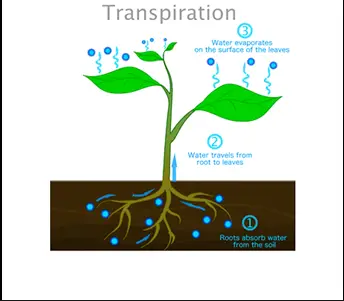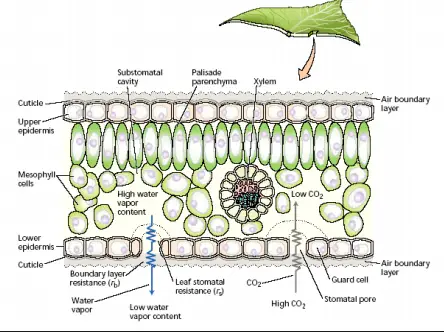Transpiration and sweating are two fundamental biological processes, each playing a critical role in the survival and functioning of living organisms. While both mechanisms involve the release of moisture, their purposes, occurrences, and impacts vary significantly across the plant and animal kingdoms. This distinction not only highlights the diversity of life’s adaptations to environmental challenges but also underscores the complexity of biological water management.
Transpiration is the process by which moisture is carried through plants from roots to small pores on the underside of leaves, where it changes to vapor and is released into the atmosphere. Sweating, on the other hand, refers to the release of liquid from the sweat glands in the skin of mammals, primarily to cool the body by heat loss through evaporation. Although both serve to regulate temperature, transpiration is crucial for nutrient transport in plants, whereas sweating is a response to elevated body temperatures in animals.
Both processes are essential for maintaining ecological balance and individual well-being. Transpiration helps in the global water cycle and climate regulation, while sweating not only cools but also expels toxins and maintains human health.

What is Transpiration?
Definition and Basics
Transpiration is a vital biological process occurring in plants. It involves the movement of water from the roots to the leaves, where it evaporates into the atmosphere through tiny openings called stomata. This process is crucial for the plant’s nutrient uptake, cooling, and internal water regulation.
Role in Plant Physiology
Transpiration plays a significant role in plant physiology. It helps maintain the flow of nutrients from the soil to different parts of the plant. This flow is driven by a water potential gradient that transpiration helps to establish, aiding in the plant’s overall health and growth.
Transpiration Process
Stomatal Function
The stomata are small pores located mainly on the underside of plant leaves. They regulate the process of transpiration by opening and closing, thereby controlling the rate of water loss. The opening of stomata is influenced by light, carbon dioxide levels, and internal water pressures within the plant.
Environmental Factors Affecting Transpiration
Several environmental factors impact the rate of transpiration:
- Light: More light increases stomatal opening, enhancing transpiration.
- Temperature: Higher temperatures can increase the rate of evaporation of water from leaf surfaces.
- Humidity: Lower humidity levels outside the leaf accelerate transpiration as the water vapor pressure gradient between the inside of the leaf and the air increases.
- Wind: Wind can remove the humidity around the leaf surface faster, increasing transpiration rates.
Benefits of Transpiration
Cooling Effects
Transpiration naturally cools plants, similar to how sweating cools humans. This cooling effect can be critical in preventing overheating, especially in sunny climates.
Water Movement in Plants
Transpiration is essential for transporting water from the roots to all parts of the plant, including the leaves. This upward movement is crucial for bringing dissolved nutrients essential for plant growth.
What is Sweating?
Definition and Human Physiological Context
Sweating is the process by which humans and other mammals excrete water and electrolytes through specialized glands in the skin. This biological function primarily aids in thermoregulation, helping to cool the body through the evaporation of sweat on the skin surface.
Sweat Glands and Their Types
There are two main types of sweat glands:
- Eccrine glands: Found over much of the body and primarily responsible for thermoregulation.
- Apocrine glands: Located mainly in the underarm and groin areas, these glands are usually associated with body odor.

Sweating Process
Mechanism of Sweat Production
The production of sweat begins in the eccrine glands. When the body temperature rises, these glands secrete a fluid that is primarily water, with small amounts of salts and other compounds. This secretion process is controlled by the sympathetic nervous system.
Role of Sweating in Body Temperature Regulation
Sweating helps regulate body temperature by providing a mechanism for heat loss through evaporation. When sweat evaporates from the skin, it absorbs heat from the body, thereby cooling it. This process is essential in preventing overheating during physical activity or in hot environments.

Benefits of Sweating
Thermoregulation
Sweating is an essential body function that aids in thermoregulation. When the body’s internal temperature rises, either from external heat or exercise, sweat glands release moisture that evaporates off the skin, effectively cooling the body. This process is critical to maintaining a stable body temperature and preventing heat-related illnesses.
Detoxification through Sweat
Sweating also plays a role in detoxification. The body expels toxins through various mechanisms, and sweat is one of these. While the primary component of sweat is water, it also contains small amounts of metabolic waste products, such as urea, salts, and toxins, aiding in their removal from the body.
Key Differences
Biological Functions
While both transpiration and sweating involve water evaporation, their biological functions differ. Transpiration is part of the photosynthetic process and nutrient distribution system within plants, critical for growth and survival. Sweating, however, primarily serves to cool the body in humans and animals, though it also has secondary roles like detoxification.
Mechanisms and Triggers
The mechanisms and triggers of transpiration and sweating also differ. Transpiration is triggered by environmental factors like sunlight and temperature, influencing the opening of stomata on leaves. In contrast, sweating is triggered by the body’s thermoregulatory center reacting to increases in core body temperature, often due to physical activity or external heat.
Effects on Organism Health
The effects on organism health also vary. Efficient transpiration is vital for plant health as it influences nutrient uptake, growth, and temperature regulation. Adequate sweating is crucial for preventing overheating in humans, contributing to thermal balance and overall health.
Impact on Ecosystem
Transpiration in Water Cycle
Transpiration plays a significant role in the water cycle. It is responsible for the release of vast amounts of water vapor into the atmosphere, contributing to cloud formation and precipitation. This process is essential for maintaining ecological balances and supporting various life forms.
Human Sweating and Environmental Interactions
Human sweating has less impact on the environment but is a critical function for individual health and survival, particularly in controlling body temperature in diverse climates and conditions.
Research and Studies
Recent Findings on Transpiration Efficiency
Recent studies have focused on improving transpiration efficiency in plants, particularly in agriculture. Researchers are exploring genetic modifications and breeding techniques to develop crop varieties that require less water while maintaining yield, which is crucial in the face of global water scarcities and changing climates.
Advances in Understanding Human Sweating
Advancements in biomedical research have led to a better understanding of human sweating. Studies have detailed the genetic factors influencing sweat production and explored treatments for conditions like hyperhidrosis. Furthermore, innovative materials have been developed for clothing that optimizes the evaporation of sweat, enhancing comfort and performance in athletic and everyday environments.
Frequently Asked Questions
How do plants transpire?
Plants transpire by absorbing water from the soil, which then travels through their vascular system to small pores called stomata, primarily located on leaf surfaces. The water evaporates into the atmosphere, a process driven by heat and light.
What triggers human sweating?
Human sweating is primarily triggered by the need to regulate body temperature. When internal temperatures rise, whether due to external heat or physical activity, the nervous system signals sweat glands to release moisture, cooling the body as it evaporates.
Are there different types of transpiration?
Yes, there are mainly three types of transpiration in plants: stomatal, cuticular, and lenticular. Stomatal transpiration occurs through the stomata, cuticular through the waxy surface of leaves, and lenticular through lenticels in woody stems.
Can sweating be excessive?
Yes, some individuals experience hyperhidrosis, a condition characterized by excessive sweating without the typical triggers like heat or exercise. This can be localized to certain body parts or generalized across the body.
Conclusion
Transpiration and sweating, though seemingly simple daily occurrences, are intricate processes integral to the survival of their respective organisms. Each mechanism is finely tuned to meet the specific needs of the organism, reflecting a remarkable adaptation to environmental and internal stimuli.
Understanding these processes not only enriches our appreciation of biological complexity but also informs broader ecological and health-related discussions. By exploring the nuances of how plants and humans manage water and temperature, we gain insights into life’s diverse strategies for thriving on Earth.

